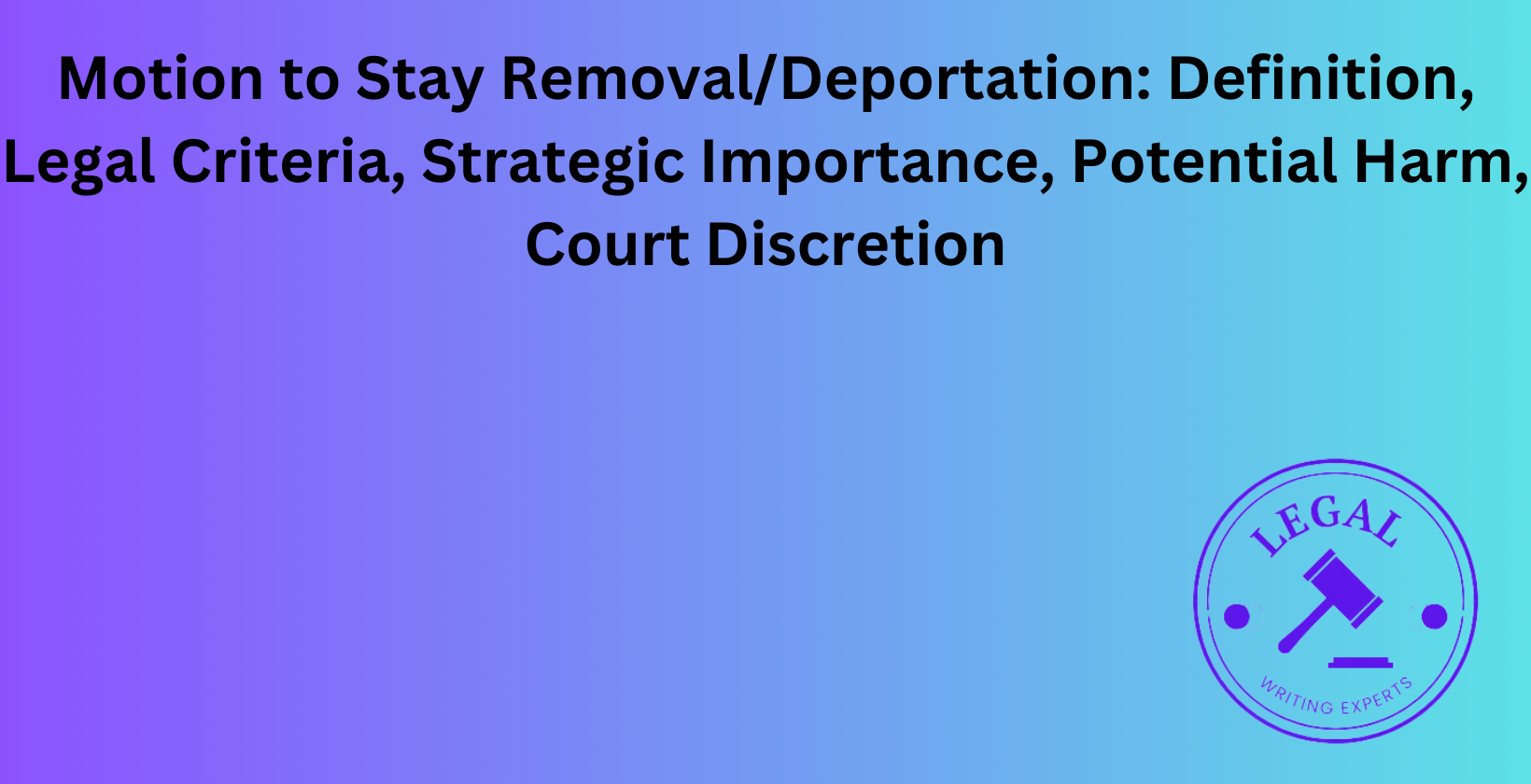Motion to Stay Removal/Deportation
Written by
Jessica E
October 7, 2024 · 8 min read

A motion to stay removal or deportation is a critical legal document in immigration law that seeks to temporarily halt the deportation process of an individual from the United States. This article explores the definition, legal criteria, strategic importance, potential harm, and court discretion involved in filing such a motion. Understanding these aspects is crucial for individuals facing deportation, their legal representatives, and those involved in the immigration process.
What Is a Motion to Stay Removal/Deportation?
A motion to stay removal/deportation is a formal request submitted to a court or immigration authority to temporarily suspend the execution of a deportation order. This legal document allows individuals to remain in the United States while their immigration case is pending or under review. The motion serves as a crucial tool for those seeking to avoid immediate removal and provides an opportunity to present additional evidence or pursue alternative forms of relief.
How to Write a Motion to Stay Removal/Deportation?
Writing a motion to stay removal/deportation requires careful attention to legal details and persuasive argumentation. The document should include a clear statement of facts, legal arguments supporting the stay, and evidence demonstrating the potential harm of deportation. It’s essential to cite relevant case law, statutes, and regulations to strengthen the motion. The writing should be concise, well-organized, and tailored to the specific circumstances of the case. Legal writers often use templates or specialized software to ensure all necessary components are included.
Where to Hire a Legal Writer to Draft a Motion to Stay Removal/Deportation?
Legal writers specializing in immigration law can be hired through Legal Writing Experts channel. Legal Writing Experts often employ in-house legal writers or contract with freelance professionals. Legal Writing Experts is an online platform that offers specialized legal writing services and provides access to experienced legal writers. We also offer expertise in drafting complex immigration documents. When selecting a legal writer, consider their experience in immigration law, familiarity with current regulations, and ability to produce high-quality, persuasive legal documents.
How to File a Motion to Stay Removal/Deportation?
Filing a motion to stay removal/deportation involves several steps. The motion must be submitted to the appropriate court or immigration authority, such as the Board of Immigration Appeals or the federal circuit court with jurisdiction over the case. The filing process typically includes:
- Preparing the motion document
- Gathering supporting evidence
- Paying required filing fees
- Serving copies to opposing counsel
- Submitting the motion within specified deadlines
It’s crucial to follow the specific procedural rules of the court or agency where the motion is being filed to ensure proper consideration.
What Are the Legal Criteria for Filing a Motion to Stay Removal/Deportation?
The legal criteria for filing a motion to stay removal/deportation include demonstrating a likelihood of success on the merits of the underlying case, showing irreparable harm if deportation occurs, and proving that the balance of equities and public interest favor granting the stay. Courts consider factors such as the individual’s ties to the United States, family relationships, length of residence, and potential hardships faced upon return to their home country. The strength of the legal arguments and supporting evidence plays a crucial role in meeting these criteria.
What Is the Strategic Importance of Filing a Motion to Stay Removal/Deportation?
The strategic importance of filing a motion to stay removal/deportation lies in its ability to provide critical time and legal protection. This legal maneuver allows individuals to remain in the United States while pursuing other forms of relief or appealing their case. It can prevent premature deportation that might separate families or expose individuals to dangerous conditions in their home countries. Strategically, a stay of removal can create opportunities for gathering additional evidence, exploring alternative legal options, or negotiating with immigration authorities.
How Does a Motion to Stay Removal Affect Potential Harm to the Individual?
A motion to stay removal significantly impacts potential harm to the individual by preventing immediate deportation. Granting the stay allows individuals to avoid separation from family members, maintain employment, and continue accessing necessary medical care or educational opportunities in the United States. It mitigates the risk of returning to potentially dangerous or unstable conditions in their home country. The motion highlights the specific harms that deportation would cause, emphasizing the importance of allowing the individual to remain while their case is pending.
What Are the Procedural Steps for Filing a Motion to Stay Removal?
The procedural steps for filing a motion to stay removal include:
- Drafting the motion document
- Gathering supporting evidence and affidavits
- Reviewing and finalizing the motion
- Filing the motion with the appropriate court or agency
- Serving copies to opposing counsel
- Paying required filing fees
- Attending any scheduled hearings or responding to requests for additional information
Adhering to specific court rules and deadlines is crucial throughout this process.
How Do Courts and Immigration Authorities Exercise Discretion in Granting a Stay of Removal?
Courts and immigration authorities exercise discretion in granting a stay of removal by carefully weighing various factors. They consider the strength of the legal arguments presented, the likelihood of success on the merits of the underlying case, and the potential harm to the individual if deported. Factors such as family ties, community involvement, and length of residence in the United States are evaluated. The court or authority may consider public interest factors and the impact of the decision on immigration policy. Discretion is exercised on a case-by-case basis, taking into account the unique circumstances of each situation.
What Happens If a Motion to Stay Removal Is Denied?
When a motion to stay removal is denied, the individual becomes subject to immediate deportation. The denial may trigger the execution of the existing removal order. In some cases, there may be options to appeal the denial or file an emergency motion with a higher court. Individuals facing denial should consult with their legal representatives to explore any remaining avenues for relief or prepare for the possibility of deportation. It’s crucial to act quickly and strategically in response to a denial to protect the individual’s rights and explore all available options.
What Are the Differences Between Automatic and Discretionary Stays of Removal?
Automatic stays of removal are granted by law in certain situations, such as when a timely motion to reopen is filed in specific circumstances. These stays take effect without requiring a separate court order. Discretionary stays, on the other hand, require a specific request and are granted at the discretion of the court or immigration authority. Discretionary stays involve a more detailed evaluation of the individual’s case and circumstances. While automatic stays provide immediate protection, discretionary stays offer flexibility for cases that don’t meet the criteria for automatic stays but still merit consideration.
What Case Examples Illustrate the Use of a Motion to Stay Removal?
Case examples illustrating the use of a motion to stay removal often involve individuals with strong ties to the United States or compelling humanitarian circumstances. For instance, a case might involve a long-term resident with U.S. citizen children who discovers a previously unknown ground for relief. Another example could be an individual seeking asylum based on changed conditions in their home country. These cases demonstrate how motions to stay removal can provide crucial protection for individuals with complex immigration situations or those facing potential harm upon deportation.
What Are the Common Grounds for Seeking a Stay of Removal?
Common grounds for seeking a stay of removal include:
- Pending appeals or motions to reopen
- New evidence supporting eligibility for relief
- Changed country conditions affecting asylum claims
- Medical emergencies or ongoing treatment
- Family separation concerns, especially involving U.S. citizen children
- Errors in the original removal proceedings
- Eligibility for new forms of relief due to changes in law or personal circumstances
Each ground requires specific evidence and legal arguments to support the request for a stay.
How Does a Stay of Removal Affect an Appeal Process?
A stay of removal significantly impacts the appeal process by allowing the individual to remain in the United States while their appeal is pending. This preservation of status quo ensures that the appeal can proceed without the complications of a premature deportation. The stay provides time for thorough preparation of appeal documents, gathering of additional evidence, and presentation of arguments before the appellate body. It prevents the appeal from becoming moot due to the individual’s removal and maintains the integrity of the appellate process.
How Can You Oppose a Motion to Stay Removal/Deportation?
Opposing a motion to stay removal/deportation involves challenging the legal and factual basis of the motion. The opposition should address each argument presented in the motion, providing counterarguments and evidence that refute the claims. Key strategies include demonstrating a lack of likelihood of success on the merits, arguing that the balance of equities does not favor a stay, or showing that granting the stay would be contrary to public interest. The opposition should be filed within the specified timeframe and follow all procedural requirements of the court or immigration authority handling the case.
Meet the Author
Distinguished linguist at Legal Writing Experts
Jessica is an expert legal writer with a remarkable blend of legal knowledge and linguistic precision. She earned her Juris Doctor degree from Duke University, where she attended on a prestigious Law Faculty Merit Scholarship. At Duke, Jessica demonstrated her exceptional abilities by serving as an editor of the Duke Law Review.
After graduating, Jessica further refined her skills during a two-year appellate clerkship at a distinguished law firm in North Carolina. Throughout law school, she enhanced her research and writing expertise as a research assistant and writer for various legal firms. Jessica’s deep understanding of legal language and meticulous attention to detail make her an invaluable asset to our legal writing services.


